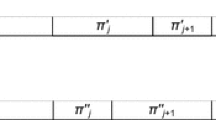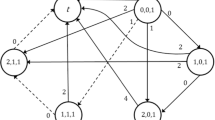Abstract
In this paper, we study the minimization of variance of cycle times in a dynamic single machine system where jobs arrive continuously over time. Numerous production systems give rise to single machine models, and a multiple-machine environment where the performance of a bottleneck machine determines the performance of the entire system reduces to a single machine problem [16]. Minimizing cycle time variance helps in safe predictions of the completion of job production and thus in providing the same quality of service to the customers. This allows an improved ability to meet the due dates reliably, and thus the greater coordination with further downstream operations on the jobs, as highly preferred in semiconductor manufacturing. Scheduling the bottleneck process to minimize the time of presence of the jobs in process minimizes the deterioration of cycle time-related performance measures. Low values of cycle time-related measures are also preferred for low risk of wafer contamination associated with it during processing. New scheduling rules are developed to minimize both the cycle time variance and the maximum cycle time for single machine system, wherein the machine/process is always utilized to the maximum extent and in the extreme case is heavily loaded with jobs for processing. The performance of the proposed rules is compared with the rules available in the literature and the results are presented for the objectives of minimizing cycle time variance and maximum cycle time at higher levels of machine utilization.
Similar content being viewed by others
References
Bagchi U, Sullivan RS, Chang YC (1987) Minimizing mean squared deviations of completion times about a common due date. Manage Sci 33:894–906
Blackstone JH, Philips DT, Hogg GL (1982) A state of art survey of dispatching rules for manufacturing job shop operations. Int J Prod Res 20:27–45 doi:10.1080/00207548208947745
Conway RW, Johnson BM, Maxwell WL (1960) An experimental investigation of priority dispatching. J Ind Eng 11:221–230
Conway RW, Maxwell WL (1962) Network dispatching by the shortest-operation discipline. Oper Res 10:51–73
Eilon S, Chowdhury IG (1977) Minimizing waiting time variance in the single machine problem. Manage Sci 23:567–575
Glassey CR, Resende MGC (1988) Closed-loop job release control for VLSI circuit manufacturing. IEEE Trans Semicond Manuf 1:36–46 doi:10.1109/66.4371
Hall NG, Kubiak W (1991) Proof of a conjecture of Schrage about the completion time variance problem. Oper Res Lett 10:467–472 doi:10.1016/0167-6377(91)90024-J
Haupt R (1989) A survey of priority rule based scheduling. OR Spectrum 11:3–16 doi:10.1007/BF01721162
Holthaus O, Rajendran C (1997) Efficient dispatching rules for scheduling in a job shop. Int J Prod Econ 48:87–105 doi:10.1016/S0925-5273(96)00068-0
Kanet JJ (1981) Minimizing variation of flow times in single machine systems. Manage Sci 27:1453–1459
Kim J, Leachman RC, Suh B (1996) Dynamic release control policy for the semiconductor wafer fabrication lines. J Oper Res Soc 47:1516–1525
Kubiak W (1993) Completion time variance minimization on a single machine is difficult. Oper Res Lett 14:49–59 doi:10.1016/0167-6377(93)90019-D
Kubiak W, Cheng J, Kovalyov MY (2002) Fast fully polynomial approximation schemes for minimizing completion time variance. Eur J Oper Res 137:303–309 doi:10.1016/S0377-2217(01)00211-9
Law AM, Kelton WD (1984) Confidence intervals for steady-state simulations: I. A survey of fixed sample size procedures. Oper Res 32:1221–1239
Merten AG, Muller ME (1972) Variance minimization in single machine sequencing problems. Manage Sci 18:518–528
Pinedo M (1995) Scheduling theory, algorithms and systems. Prentice Hall, Englewood Cliffs
Rajendran C, Holthaus O (1997) A comparative study of dispatching rules in dynamic flowshops and jobshops. Eur J Oper Res 116:156–170 doi:10.1016/S0377-2217(98)00023-X
Ramasesh R (1990) Dynamic jobshop scheduling: a survey of simulation research. OMEGA 16:43–57 doi:10.1016/0305-0483(90)90017-4
Russell RS, Dar-el EM, Taylor BW III (1987) A comparative analysis of the COVERT job sequencing rule using various shop performance measures. Int J Prod Res 25:1523–1540 doi:10.1080/00207548708919930
Ventura J, Weng MX (1995) Minimizing single machine completion time variance. Manage Sci 41:1448–1455
Wein LW (1988) Scheduling semiconductor wafer fabrication. IEEE Trans Semicond Manuf 1:115–130 doi:10.1109/66.4384
Author information
Authors and Affiliations
Corresponding author
Rights and permissions
About this article
Cite this article
Gupta, A.K., Ganesan, V.K. & Sivakumar, A.I. Cycle time variance minimization in dynamic scheduling of single machine systems. Int J Adv Manuf Technol 42, 544–552 (2009). https://doi.org/10.1007/s00170-008-1611-5
Received:
Accepted:
Published:
Issue Date:
DOI: https://doi.org/10.1007/s00170-008-1611-5




